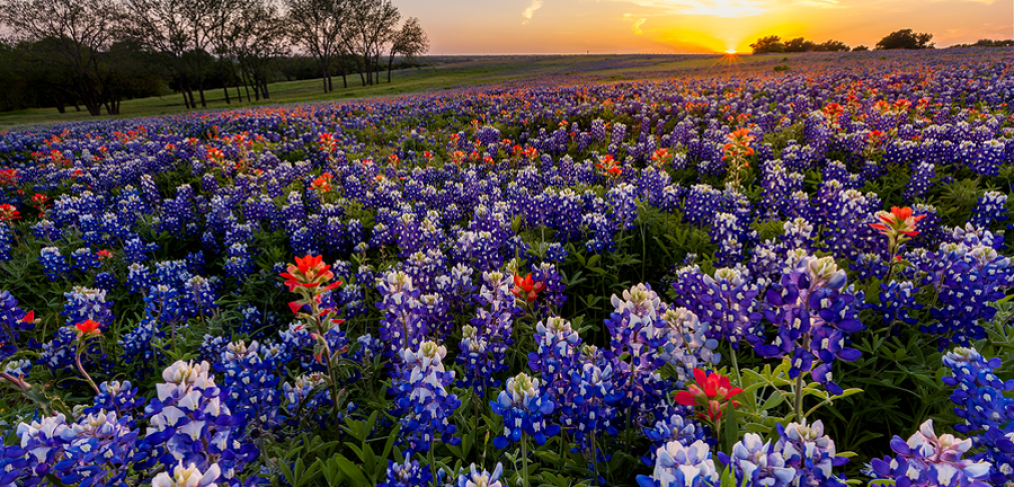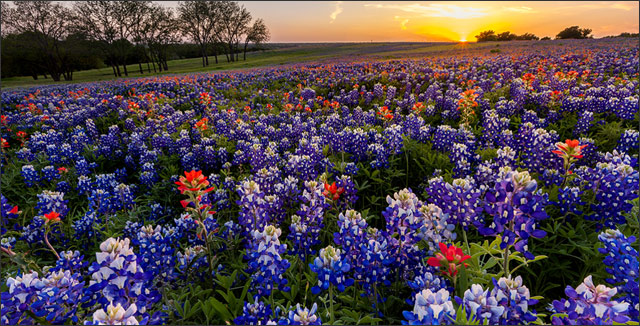
How to Cultivate Wildflower Meadows – Gardening Tips

Wildflower meadows in Texas
In terms of wildflower plantings, the most beneficial to wildlife and sustainable plants are native perennials and grasses. So, that can be your gold standard of wildflower meadows, if you will. Those flowers and grasses are the species most animals in your area are adapted to.
You will see animals quickly returning to your backyard the more native perennials you have. You will also have to do less seeding and mowing in the coming years.
It can, however, take a few years and careful cultivation to restore a truly native and self-sustaining wildflower meadow.
In our previous article, How to Grow a Wildflower Meadow, we talked about soil types and locations for your wildflower meadow. I mentioned a few methods for ridding your soil of weeds and grasses. This week I want to talk about some methods for introducing native plants and helping them best to thrive.
The reason native perennials can be hard to establish is that they tend to be slow-growing plants and don’t compete well with the kinds of weeds that really thrive in disturbed lawns or garden soils. In general, what’s good for a garden is good for your potential wildflower patch – tilled soil with added manure or compost.
However, garden weeds are the killer. While you are improving your soil’s texture and drainage with added organic material, you should also allow for one or two seasons of dedicated weed killing, using the methods I described last week.
How to Cultivate Wildflower Meadows
Which Plants to Choose?
In addition to the resources included in our previous article, one good idea for gaining insight into which plants are truly native is to spend some time in restored prairie or meadow land – or any native prairie – you have available nearby.
It is fine to take into consideration the pictures on the back of a package of wildflower seeds, but keep in mind your end goal: you want to create a whole ecosystem. This means you want plants that have a symbiotic relationship with one another. Wild grasses and wildflowers, for instance, have this type of relationship. That’s not something you’d automatically know by looking at a package.
People are often your best resource when choosing where to begin. Local nature conservancies have employees whose job it is to know this stuff. Local natural landscaping groups will also be able to provide much-needed expertise. A wildflower field guide – like the Knopf Guides for the National Audubon Society – will help greatly as you trek through your local nature retreat.
Preparation Phase 2
I’m calling this phase 2 because you will likely have good quality soil that is relatively weed free by this point. Your next goal is to establish perennials. There are several ways to go about this, and none is the “right” way. It may be that what works in one area of your yard doesn’t work in another. The truth is many of our yards have soil that was taken from all over, rather than the rich earth found in ancient prairies before development started.
One method is to simply plant everything you want to establish and weed, weed, weed. After you’ve done your research and found seeds, decide on a spring or fall planting. They each have their pros and cons.
In fall, plants are less likely to get competition from weeds also trying to germinate. Wildflower seeds do best when planted in the fall.
In the spring, your plants will have more time to get established. This is when native grasses germinate best. You can also “dig in” mature native plants after a spring planting – especially if they already grow elsewhere on your property or nearby properties.
I’ve previously mentioned the idea of rescuing native plants being uprooted by development. This requires getting permission from builders and owners, but it might serve the purpose of rescuing a mature plant as well as creating your own wildflower meadow.
Method 2
Another method is to plant the site in non-native annual wildflowers and gradually sow in perennials, which will take over eventually as the annuals die back. Non-native annuals are the colorful plantings we often see along highways. They’re not as self-sustaining and certainly not going to last forever, but they can be very colorful and relatively hearty. They will also still provide some habitat for bugs and birds. They will re-seed to some extent, even as you dig, amend and replant the soil with native species.
You may also consider sowing a fall cover-crop like oats. This can be especially helpful if you need help getting rid of an invasive species. The dead plants make excellent mulch when left in place. Buckwheat planting in summer will also offer a great weed-suppressing alternative.
Technique
Seeds need to be buried in a quarter inch of soil. A roller works best for large patches of land, but you can also press seeds by walking around and tapping with the flat side of a hoe or shovel.
First Season
The main task in your first season after planting is to mow. A new meadow needs to be mowed every three weeks or so – at about 4-8 inches tall. If you have a lawn mower that can be raised to at least 4’’, you can use that. Otherwise, a weed wacker will work. It doesn’t have to be exact, it just needs to give the plants a chance to fill out their crowns and absorb much-needed sunlight and develop deeper root systems.
It also keeps the weeds from setting seeds. As you weed, you want to cut invasive species at ground level with a sharp knife, rather than pulling. Pulling will actually spread seeds.
Second Season
The second year will involve less mowing but more weeding – in the same fashion, with a sharp knife or set of shears.
Third Season
You can start to rest easy now – in the third season – very little weeding or mowing will be needed. You can mow once a year in the fall – probably with a weed trimmer with a blade attachment as a lawn mower won’t work at this point. Chop everything down to 4 inches. This will help the meadow disperse seed. After a few more years, you can mow in the spring and allow the plants to remain over the winter, which provides and even longer habitat for animals.
Take Away
Creating and cultivating a wildflower meadow on your own land will not only benefit you by giving you an ever-evolving project and a useful body of knowledge, but it will create a much-needed habitat for local birds and bugs you love to watch.



